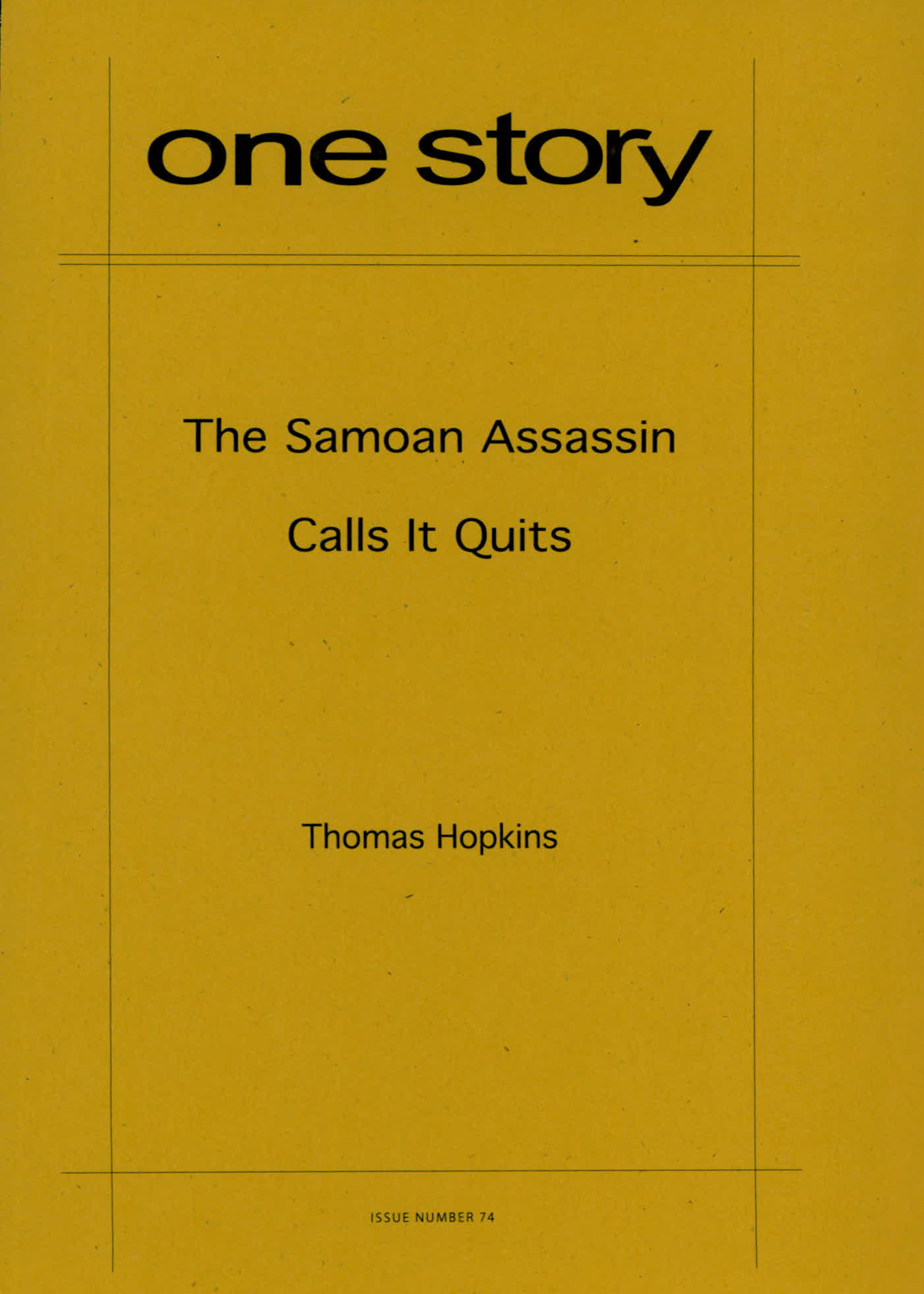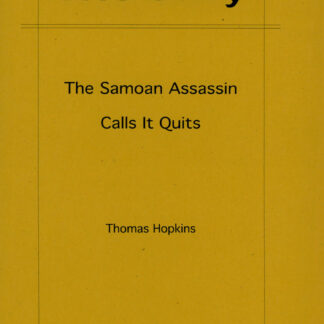
The Samoan Assassin Calls It Quits
$2.50
46 in stock
Excerpt
When Daniel came back from the car with his duffel bag, and started unpacking a whole array of weaponry—multiple submachine guns, pistols, silencers, even a small cache of knives—and stashing it all under their motel bed, Sadie was horrified, but there wasn’t much she could do about it, as she was still handcuffed to the bed frame, not to mention still very much naked.
“Oh, Daniel, crikey,” she yelled. “You really weren’t kidding before, were you?”
“Whoops,” he said. “I’m sorry. I thought you understood that.”
“You really are an assassin,” she said. She wasn’t crying, exactly, but she was very close to it. “Oh, yikes. I’m not sure if I’m entirely comfortable with that.”
“Sadie, hey, take it easy.” He got up and sat on the edge of the bed. “Shh,” he said. He stroked her hair. “I’m sorry. I’ve been entirely truthful with you. This is my business. And I certainly wasn’t lying about wanting to get out of this business.”
Thomas Hopkins
To get from the Massachusetts town where Thomas Hopkins was born to the town where he did most of his growing up, you head east on Route 2, then up 495 until you get to the exit for Route 28, although you might save time by getting off earlier at the 113 exit. Tom shares a birthday with Matthew Broderick and Bridget Jones, which seems about right. His fiction has appeared in One Story, Pindeldyboz, Quick Fiction, and the anthology Homewrecker: An Adultery Reader. He has also written a few articles for Poets & Writers. His website is www.tomhop.com. He is happy to be here.
Q&A by Hannah Tinti
- HT: Where did the idea for this story come from?
- TH: About a year and a half ago I asked my brilliant writer friend Jessica Anthony for two story restrictions: a topic and a rule. I love challenges like that—I prefer wrapping my mind around a specific task, rather than staring down the nothingness of the blank page, even if the original task gets lost in the final incarnation. She wrote back: “Topic: Leaf-peeping. Rule: Must include Biblical metaphor.” That’s how this got started.
- HT: What was the most challenging aspect of writing this story?
- TH: The character of Daniel. I feel like I know Sadie well, from my own experience growing up in Massachusetts. The life of a hired killer from the South Pacific in search of a green card, on the other hand, I am less familiar with. I’m nervous about having gotten his heritage right. The details come from my father’s experience as a Peace Corps volunteer in the Kingdom of Tonga, Julia Whitty’s marvelous “A Tortoise for the Queen of Tonga,” and some histories and scholarly works I looked at, such as Helen Morton Lee’s Tongans Overseas: Between Two Shores. But I’m still worried I’ll get angry letters from Nuku’alofa.
- HT: Why did you make the Samoan assassin in this story from Tonga?
- TH: Both characters in the story hate the part of themselves that was formed by the place where they were raised; both would like to become, or own, or love, that place’s opposite—and from what I know of it, Tonga sounds like New England’s antipode. A songwriter I knew back in Somerville, years ago, described this much more succinctly in one of his lyrics: “I want to see you! I want to be you!” The blur of those two feelings can be dangerous.
- HT: Do you consider yourself a Massachusetts writer? How has New England influenced your work, beyond “packies” and “rotaries”
- TH: I hope I’m not. Regional writing, whatever the region—to my mind, anyway—seems like something that veers awfully close to parochial stand-up comedy, like, “Hey, so what’s the deal with that ‘Big Dig,’ huh? I mean, c’mon!” It’s got the shelf life of milk. I’d like to think I’m up to something more cosmopolitan. Or at least something more wicked pissah. That said, I have written a number of stories set in New England—although it’s a New England full of zombies, severed heads, botched circumcisions, murderous entrepreneurs, time-traveling cult leaders, feral hippie children, and mermaid drug dealers. You know, universal issues.
- HT: How long did it take you to complete this story?
- TH: In the earliest version of this, the one I wrote from Jessica’s original rules, Sadie and Daniel met on an Internet dating site. It didn’t work very well. A year ago, when I was finishing my final project at NYU’s Creative Writing Program, I had to make the piece work for the group I was handing in, because Daniel and Sadie pop up in another story later on. They had to be in there. So I spent the weekend before the deadline unpacking the thing, doubling its length, throwing out the Internet, adding guns, printing out and cutting up and taping together the different sections, laying all twenty of them out all over every single flat surface in my living room, and then assembling the order I felt told the story best. Eleven drafts and a year and a half and two frantic days and one eagle-eyed editor after the original impetus, you get this.
- HT: Why did you arrange the scenes out of order, and what is the rationale behind the order they are in—for example, why did you begin with the revelation that Daniel was an assassin, and end with Daniel and Sadie leaving the party?
- TH: The scenes were in a nonlinear order from the very first draft. To be honest, I can’t remember what I was thinking originally, but the weekend I spent rearranging everything, the question was: This story can’t work chronologically, so what’s the best way it can work? I like the first scene of the story being the most traumatic, and the last being the most optimistic, and the way the former colors the latter. I hope the whole story works that way—that a narrative adds up, scene by scene, in terms of what the reader knows, and what he or she knows the characters don’t know. But I also hope that the scenes are less confusing and off-putting to the reader, and more artful, than they might be if they were laid out in a strictly reverse chronological arrangement. It’s the difference between Harold Pinter’s Betrayal and Václav Havel’s The Increased Difficulty of Concentration. Both are incredible plays, with very different nonlinear strategies, both of which are utterly necessary to their respective plots.
- HT: Sadie has a degree in film studies, and her movie references, along with the structure and plot, give the story a cinematic feel. How have movies influenced your writing?
- TH: I worry that movies have made me impatient as a reader. Or lazy as a writer. But I hope that there’s other influences that are more positive. With this particular story, I definitely had in mind the structure of Pulp Fiction. And the way scenes get cut up and rearranged in Out of Sight. I love all the movies mentioned in the story, and feel like I’m borrowing from at least a few of them—the absurdity of A Life Less Ordinary, maybe, or even the road trip in It Happened One Night. I certainly wish I could write something as good as the first night Clark Gable and Claudette Colbert spend together—that’s some seriously hot dialogue.
- HT: What is the best bit of advice about writing you have ever received?
- TH: Anne Lamott’s chapter about shitty first drafts, and how necessary they are, in Bird by Bird. Something Julio Cortázar said in his Paris Review interview about how he did not write every single day, which I found encouraging. Something George Saunders wrote in his essay “The Battle for Precision”: “Specificity, precision, and brevity, applied in language, drive us towards compassion.” Does that count as advice? It certainly inspires me to keep working.
- HT: What are you working on now?
- TH: A second collection of stories, all of them very short. (Which is another way of saying, “I don’t have an agent.”) They involve, so far, depressed ghosts, enthusiastic hookers, sacrificial virgins, bored soldiers, anthropomorphic geology, magic potions, human flight, adulterous touring theater companies, giants, soothsayers, pole dancers, a self-loathing demiurge librarian, a princess who turns into a dolphin, the logistics of sex on a leaky air mattress, a little light bondage and discipline, and a case of the clap. I’d like to think it’s all aiming for something like Italo Calvino’s Invisible Cities, Cortázar’s Cronopios and Famas, or Angela Carter by way of Pee-wee’s Playhouse, but who knows? I’m excited to see what it all becomes.
